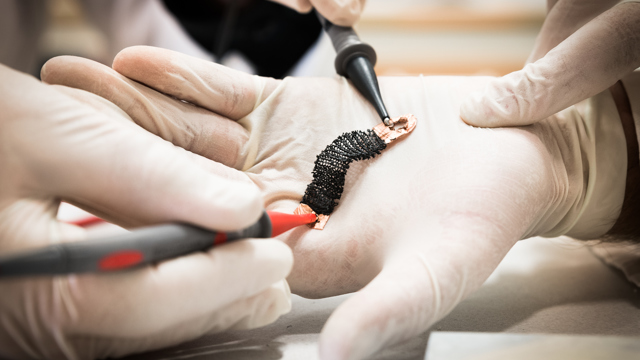A prototype strip of "textile muscle". Photo credit Thor Balkhed
The research project will be led from the University of Twente in the Netherlands and is to develop a completely new type of clothes known as haptic clothes. The new textiles will give mechanical feedback to the wearer, in the form of gentle pressure or a stroking sensation. The applications are many. Researchers working in the project suggest that feedback-enabled clothes can, for example, provide blind people with information about their surroundings and help the wearer navigate without sight. Another application may be found within ergonomics, using mechanical feedback to help the wearer improve movement and posture, while the gaming and entertainment industry may use new clothes to intensify the experiences of virtual and augmented reality.Edwin Jager.
The Wearable Electroactive Fabrics Integrated in Garments project (abbreviated as “WEAFING”) has been granted EUR 3.8 million (approximately SEK 39 million) for the period 2019-2023. Of these, approximately SEK 7 million are for work at Linköping University, LiU. Edwin Jager, who works with textile muscles, will be responsible for LiU’s part of the project.
“This is an extremely interesting project, and the duration, 4½ years, means that we have time to carry out in-depth work. We start pretty much immediately.”
From textile to prototype
Edwin Jager’s group, in collaboration with, among others, Nils-Krister Persson from the Swedish School of Textiles at the University of Borås, are developing textiles that have the ability to contract and produce a force, in the same way that live muscles create force. They are using an electroactive fabric that alternately contracts and expands when a weak voltage is applied. At the moment, the material only works together with a liquid to conduct the current, an electrolyte, and this is somewhat impractical. The next step for the scientists is to improve the technology such that it works in dry conditions.Edwin Jager from Linköping University (right) and Nils-Krister Persson from the University of Borås (left) mounting a textile actuator into an instrument that measures force. Photo credit Thor Balkhed
“A research group in France is to develop an electrolyte gel for us, so that our textile muscles can function in air, without the need for a liquid electrolyte. Our colleagues at the Swedish School of Textiles in Borås will then knit and weave the fibres in various ways, and we can then evaluate what gives the best haptic feedback”, says Edwin Jager.
Other research groups in different countries will work within the project to integrate electronics, sensors and batteries into the textiles so that they can be worn as clothes. Others will determine which type of mechanical stimulation gives the best feedback to the wearer, and how much force is required. Some companies that work with smart textiles are also participating in the project and will create prototype clothes from the new textiles.
“The project covers the complete chain, from material to product”, says Edwin Jager.
Translated by George Farrants



